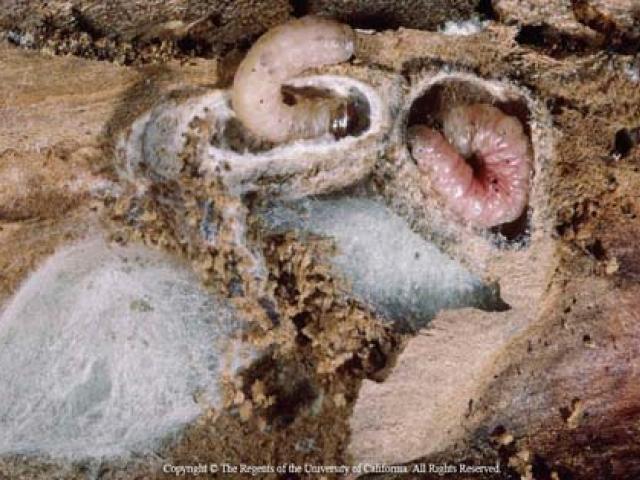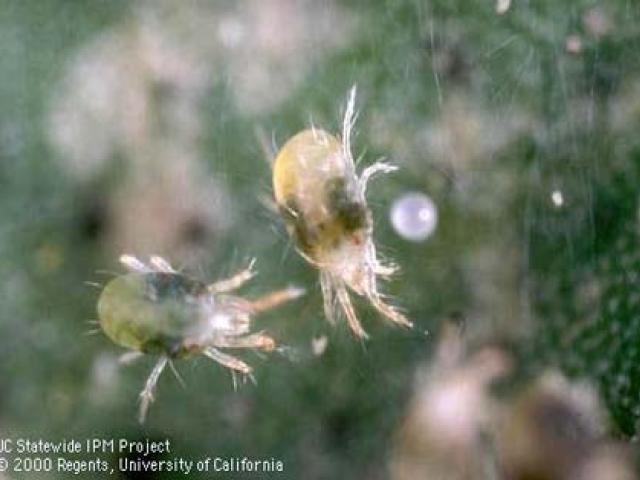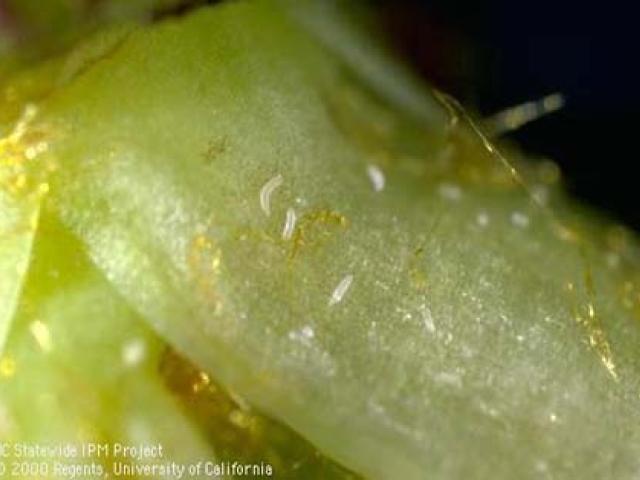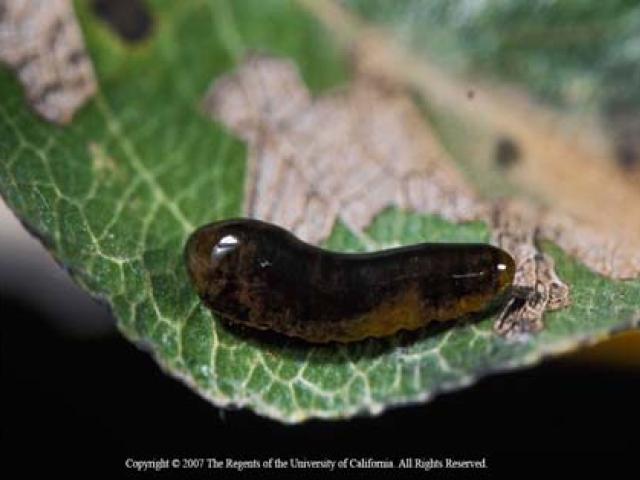The most prevalent and harmful orchard pest of pear in California is the codling moth (Cydia pomonella). Pear psylla (Cacopsylla pyricola) and the twospotted spider mite (Tetranychus urticae) are also common in California. Insect and mite damage varies within California depending on the rootstock and cultivar, weather conditions, and the use of insecticides and miticides.
Codling moth damages pear fruit directly by boring into fruit. Larvae either “sting” fruit, boring only a short distance into the flesh, or bore into the core of a fruit (deep entry). A deep entry results in unmarketable fruit because the larvae enter the core and consume the seed cavity. Codling moth only develops between temperatures of 50°F to 88°F, and can be managed with insecticides (UC IPM website, 2013).
Pear psylla is found on other tree crops, but can only fully develop on pear trees. Pear psylla are most commonly found throughout the upper sections of the tree canopy. Fruit damage occurs when pear psylla nymphs feed on leaves, producing a honeydew runoff on the fruit that supports sooty mold and black fungal growth. Mild impacts lead to fruit skin russeting, while severe problems result in fruit drop, stunting, defoliation or tree death. P. communis rootstock is the least susceptible to psylla damage. Pear psylla can be prevented by applying insecticides (UC IPM website, 2013).
Twospotted spider mites appear on fruit leaves at the bottom of the canopy after warmer weather begins, then gradually spread throughout the rest of the canopy. Mites only feed on leaves, but affect fruit by reducing photosynthesis and defoliating trees. Pre-harvest defoliation results in smaller fruit, while postharvest defoliation can affect the following year’s fruit. In both cases defoliation can result in a late fall bloom and dramatically reduce flowering in the following spring. Twospotted spider mites can be effectively controlled by other beneficial insects. If insecticides are used to prevent other pests beneficial insect populations can also be reduced, resulting in spider mite infestations. Miticides are often used to prevent and control twospotted spider mites (UC IPM website, 2013; Van Steenwyk et al. 2007).
Additional pear pests in California include: stink bugs (Halyomorpha halys), oblique banded leafroller (Choristoneura rosaceana),European red mite (Panonychus ulmi), pear rust mite (Epitrimerus pyri), pear leaf blister mite (Eriophyes pyri), and pear slug (Caliroa cerasi). Pear slug can be problematic in backyard, abandoned and organic orchards.
For detailed information, including the Year-round IPM Program for pear, and University of California's official guidelines for pest monitoring techniques, pesticides, and nonpesticide alternatives for managing pests, see the UC Statewide IPM Program: How to Manage Pests: Pears
Pear Photo Gallery
These photos are accessed from the UC ANR Repository, are available courtesy of University of California research and extension personnel and programs, including the UC Statewide IPM Project.

|

|

|
|---|---|---|
| Obliquebanded Leafroller larvae on pear. | Mature codling moth larvae. | Pear psylla. |
| Photo courtesy of Ted DeJong. | Photo courtesy of Ted DeJong. | Photo courtesy of Ted DeJong. |

|

|

|
| Two-spotted spider mite adults & egg. | Adult Pear Leaf Blister Mite on pear. | Adult stink bugs: southern green (left), redshouldered, consperse. |
| Photo by JK Clark, UC IPM © UC Regents | Photo by JK Clark, UC IPM © UC Regents | Photo by JK Clark, UC IPM © UC Regents |

|

|

|
| European red mite. | Pear rust mite. | Pear sawfly (or pear slug) larva. |
| Photo by JK Clark, UC IPM © UC Regents | Photo by JK Clark, UC IPM © UC Regents | Photo by JK Clark, UC IPM © UC Regents |
